ACTIVATING V2 BACKUPS ON SERVERS PROVISIONED BEFORE NOVEMBER 1ST
To activate backups 2.0 head to your Servers page and click on the name of the server you wish to activate it on.
Warning: This will disable Borg and purge all existing Borg backups from your system. You are responsible for ensuring you have existing backups in place. By enabling Backups v2 you accept full responsibility for this action and confirm you have alternative backups in place. Only enable if you agree to these conditions. Once enabled, this can not be disabled. Borg is going back to the Delta Quadrant.
Introduction
Backblaze B2 is an inexpensive and reliable cloud storage provider. This article will walk you through to generate a Backblaze API key and add it your vCanopy account so that you can use their service for remote website backups.
TABLE OF CONTENTS
Backblaze Pricing
Backblaze offers excellent value for money and offers 10GB of storage free with your account. Depending on your sites, this may be enough to cover your backup storage costs.
Their pricing isn’t just based on storage alone though, and there are fees for downloading and transactions. As with storage though, the cost is incredibly low and there’s a free allowance.
INFORMATION
The pricing information below is all correct as of Sept 2022. You can view Backblaze B2 pricing directly on there website here:
Backblaze B2 Cloud Storage Pricing
STORAGE COSTS
Storage costs $0.005/GB/month, and data stored with Backblaze is calculated hourly, with no minimum retention requirement.
DOWNLOAD COSTS
Downloads are charged at $0.01/GB when downloading files. The first 1 GB of data downloaded each day is free.
TRANSACTION COSTS
These costs are associated with API usage. For example, sending backup data via API.
The costs are incredibly cheap:
- Class A Transactions: Free
- Class B Transactions: First 2500 per day are free, then $0.004 per 10,000
- Class C Transactions: First 2500 per day are free, then $0.004 per 1,000
It’s possible that you may hit your free tier ceiling, though this is very rare. Caps can be configured inside your Backblaze account settings under Caps & Alerts.
Step 1. Sign up for a Backblaze account
Head over to https://www.backblaze.com/b2/cloud-storage.html and sign up for an account.
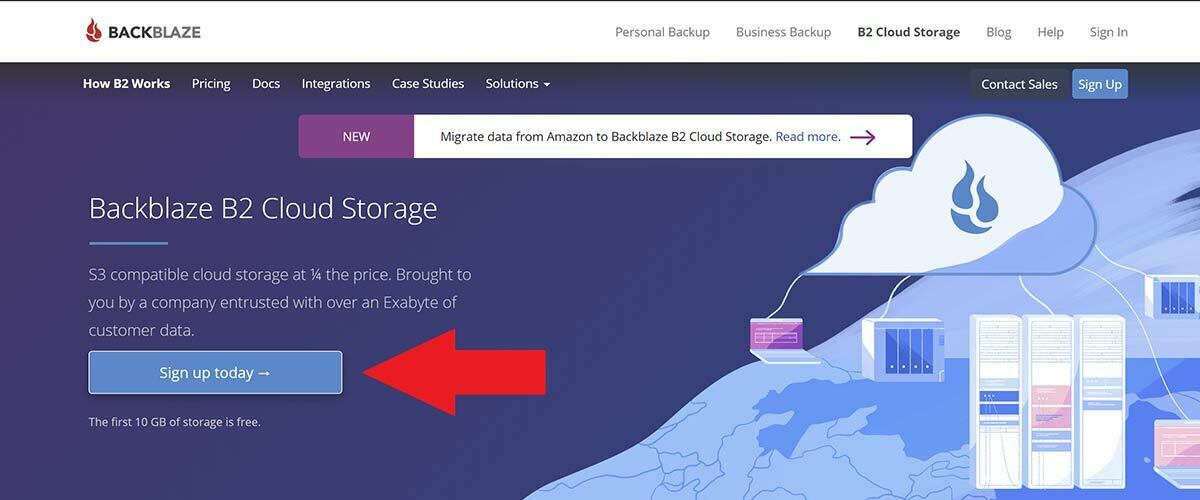
You’ll be asked for your name and email address and then to verify your email address on clicking sign up.
Your first 10GB of storage is free (which is awesome), and after that you’ll need to add a payment method. We recommend you do this immediately to ensure that the transition over 10GB is seamless when the time comes.
Step 2. Create an App Key
In the menu on the left hand side, click through to the App Keys page, and the click to create a new the Add a New Application Key button (you can ignore the master key):
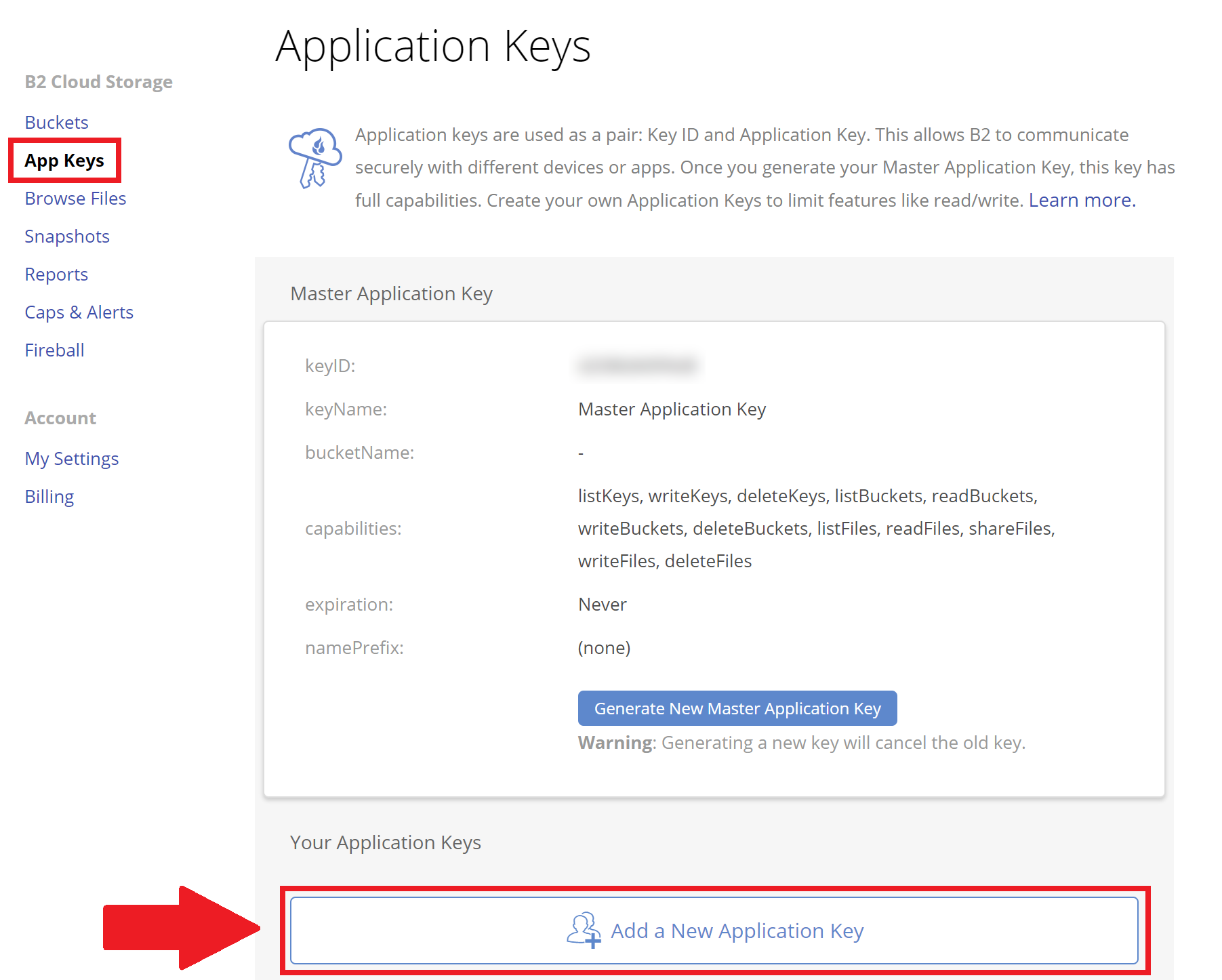
The modal as pictured below will open. Here you need to give your key a name and select the Read and Write check box:
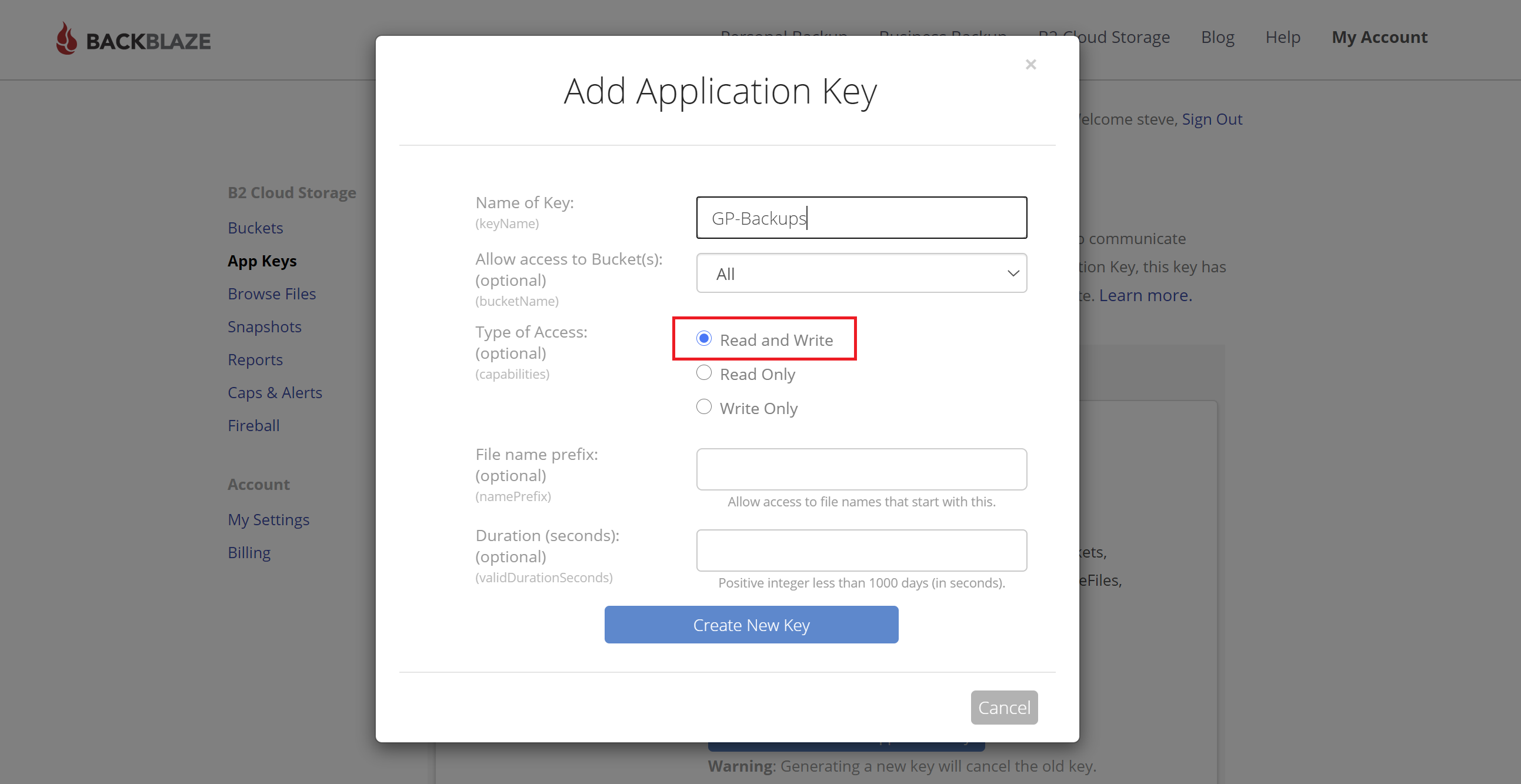
Next click the “Create New Key” button.
Step 3. Copy your API credentials
Your API credentials will appear on the page. These will only be shown the one time so be sure to copy them before leaving the page.
We need to the: –
- KeyID
- applicationKey
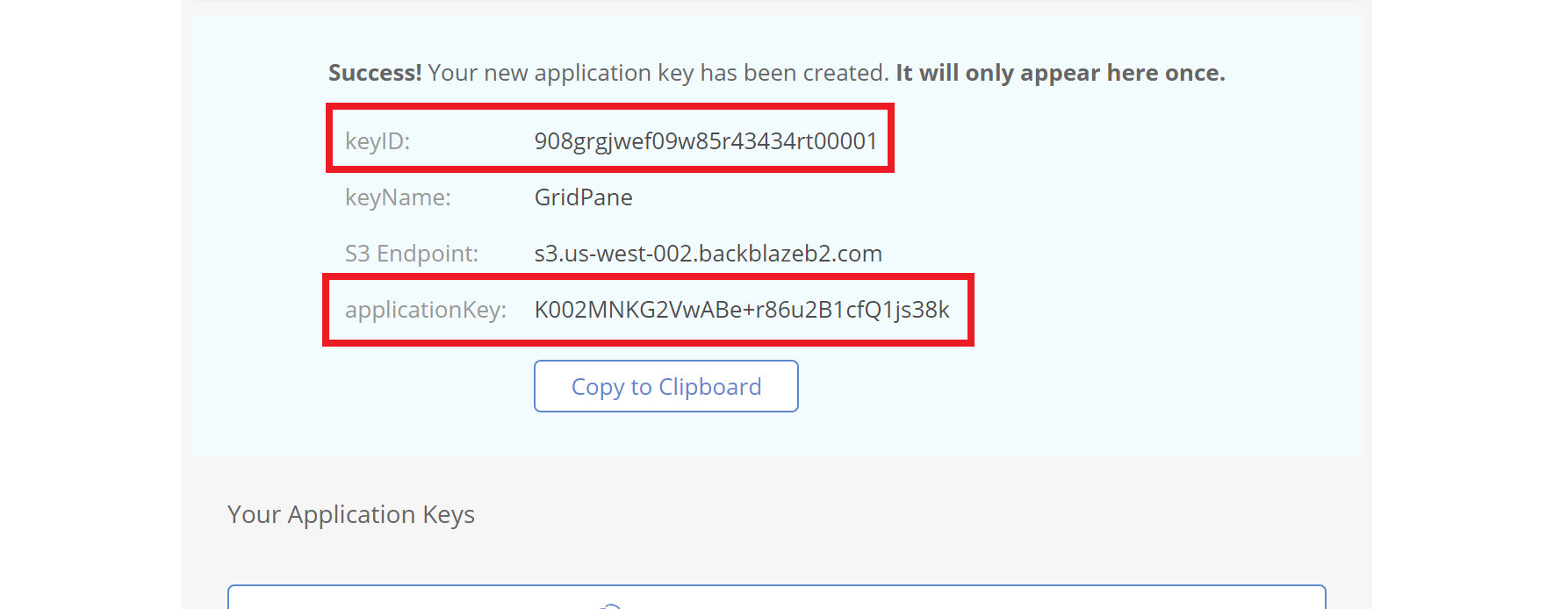
Step 4. Add your Backblaze API credentials to vCanopy
Back in your vCanopy account, click through to your settings page:

Here, click through to the Integrations page, click Backup Providers, and enter your API details in the Backblaze tab:
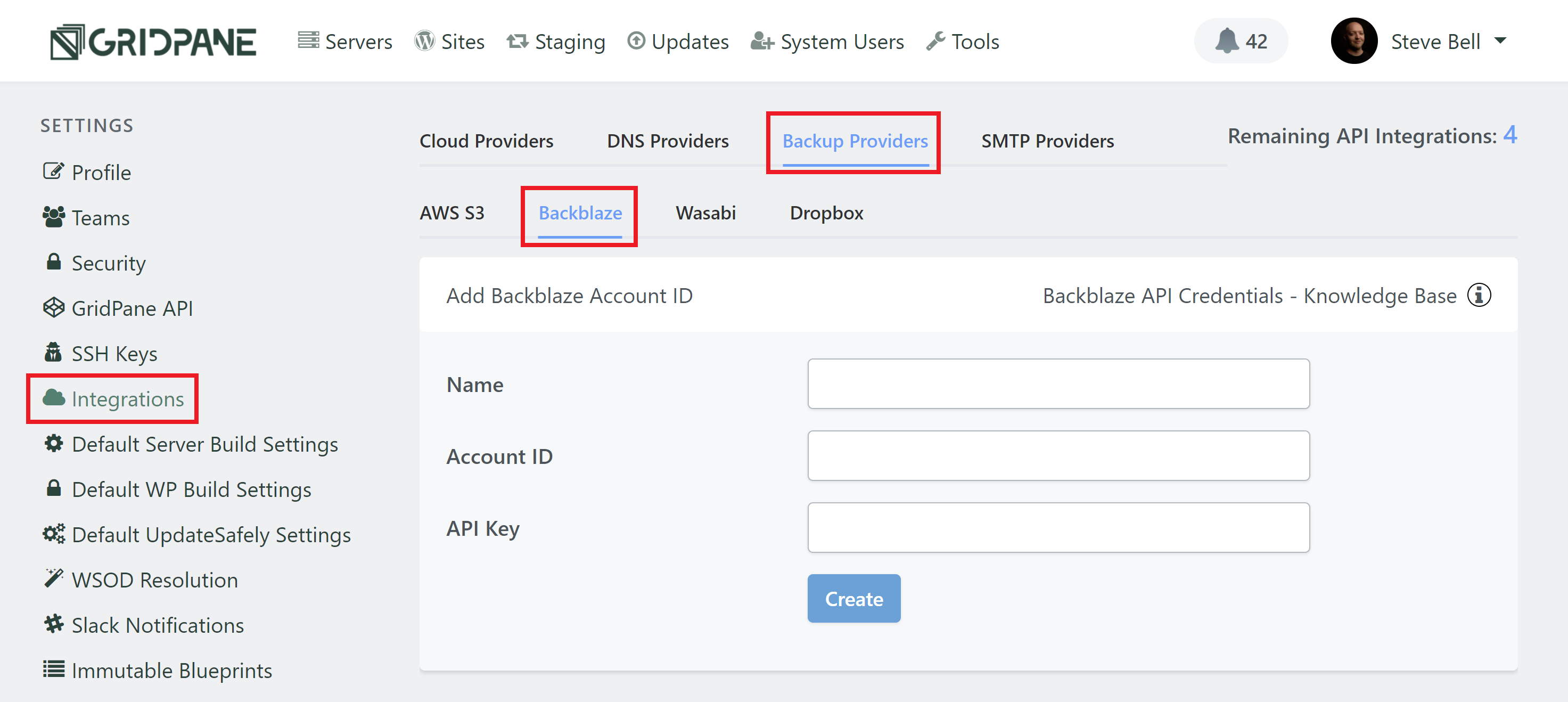
- Give your key a name.
- Your KeyID = Account ID
- Your applicationKey = API Key
- Click the Create button.
You’re all set! To learn how to configure remote backups for your websites check out the following article for a full walk-through:
Creating Individual Server Buckets without Globally Writeable Permissions
By default, our API uses globally writeable permissions. If you don’t want to give vCanopy this level of access, the following can be done instead.
HOW BUCKETS WORK
Each server has its own unique bucket. This is so that multiple servers don’t have write access to the same bucket, which wouldn’t be ideal in terms of security.
The individual server buckets follow this naming format:
vCanopy-backups-${UUID}
The ${UUID} can be found on your server with the following command:
cat /root/gridcreds/vCanopy.uuid
The output will look similar to this:
root@nginx:~# cat /root/gridcreds/vCanopy.uuid
876ac0ab-690f-4067-bdb6-9b2eec41b989
root@nginx:~#
The bucket name for this server would normally therefore be (on AWS, Dropbox, and Wasabi):
vCanopy-backups-876ac0ab-690f-4067-bdb6-9b2eec41b989
However, Backblaze has a 50 character limit, so it would be as follows, missing the last 3 digits:
vCanopy-backups-876ac0ab-690f-4067-bdb6-9b2eec41b
Backup data is encrypted on your server, is stored encrypted, and is transferred encrypted.
CREATING SERVER BUCKETS MANUALLY
To create a servers bucket manually, there’s no need for the bucket to be public so keep it set to the default of private. There’s no need to encrypt, as the data is already encrypted on your server, stored encrypted, and transferred encrypted.
Bucket Unique Name:
The bucket name you’d use is as stated above. but as Backblaze has a character limit of 50, you will need to remove the last 3 digits from the UUID. Using the example above, we would shorten it as follows:
vCanopy-backups-876ac0ab-690f-4067-bdb6-9b2eec41b
Default Encryption: Disable
Object Lock: Disable
The above is only necessary if this is something you specifically want to do. Otherwise, you can follow steps 1-4 above and leave this to vCanopy to create.
Further Reading
For further information about how backup systems work, the available options for configuring them, and for setting up remote backups (available on V2), please see the articles listed below.






